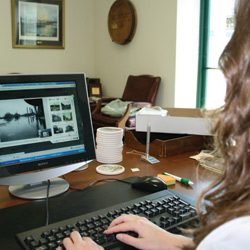
A Google-backed partnership to bring Peoria’s historical archives to the world…
We all have history to share, from the boxes of dusty old photos in our attics to the memories and stories that perhaps only we know. In archives around the world, millions of historic items languish on shelves and in boxes—objects with stories to tell, if anyone were there to hear them.
Historic preservation is just the first step. But without context—without stories attached to them—they are just old objects. And story or not, what good is a carefully preserved object if no one knows it’s there?
Increasing accessibility and adding context—these are the next frontiers of the 21st-century historian. Today’s technology makes it possible to connect these artifacts to the people with the stories, and the Peoria Historical Society stands on the cusp of this revolution.
“Instead of just presenting information, you make it interactive, and you put people to work,” says Bob Killion, PHS curator of collections and technology. “This is their collection. We wanted to give people ownership of it.” Crowdsourcing History
Crowdsourcing History
A new partnership with Historypin promises to be the most significant step the organization has yet taken to fulfill this mission. It’s a project of We Are What We Do, a U.K.-based nonprofit that creates digital tools to address major social issues around the world. Upon Historypin’s launch last month, the PHS was among just 13 participating U.S. institutions in the initiative, which features the likes of Google as its technology partner.
Through its website and mobile app, Historypin will make the PHS’ collection of historic photographs the subject of mass participation. Users can add their own photos and stories, or contribute dates, captions and other data to those already there. With their locations tagged, these images can be superimposed onto Google Maps’ Street View, and that’s when the real wow factor comes in. As you fade from the present into the historic view, the Chase building at the corner of Fulton and Adams, for example, becomes the Block & Kuhl department store as it looked in the 1920s. There’s even a timeline that can be used to “travel” through time, a feature that will increase in value as more photos are added and dated.
And with many other features—far too many to summarize here—the potential for interactive tours and other ways of leveraging the data is palpable. It’s all rather impressive, but hard to describe without actually seeing it. When Killion demonstrated the site’s functionality to the PHS Board of Directors, “there was an audible gasp when I went to Street View,” he recalls. “And the fact that you can gather all these stories…the opportunities for how we can interact with people are endless.”
Tying It All Together
For Killion, the project’s launch is the culmination of several years of examining ways to increase the value of the PHS collection. “We’re taking our collections database and making it accessible to the public,” he declares, noting the rather convoluted nature of the current process.
“We had all of this information,” says PHS Executive Director Walter Ruppman. “The next step was to tie it all together.” As users add their own stories and memories, Historypin stands to breathe new life into the collection, enabling students, teachers, researchers and the just plain curious to explore the content freely. It also affords an opportunity to generate a modest income—a great benefit to an organization that survives almost entirely on memberships and donations. “We see this as sustainability,” Ruppman adds.
Historypin has ambitious goals, and with Google’s backing, the future appears bright, indeed. At July’s launch party, Nick Stanhope, CEO of We Are What We Do, imagined “images, video and audio clips pinned on every street, in every building, across and between every village, town and city. Around these pins, a rich web of stories and recollections, interwoven with other types of memory—diaries, letters, records. We are creating a global digital archive of the people’s history.”
For the Peoria Historical Society, the launch of Historypin marks the beginning of a new era. “Our focus had been on collecting and preserving, but the technology is now there for us to make it easy for virtually anybody to have access to the collection, interact with the collection, and add historical value to it,” says Killion. “We really feel like what we’re doing is going to open up Peoria to the world.” iBi

